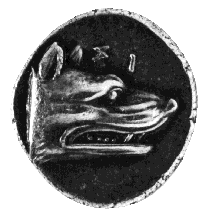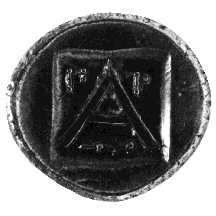



(33) Argos, Argolis (Greece) - AR obol, 322-229 B.C., 0.88 g.
(inv. 91.075).
Obverse: Head of wolf r.; above.
Reverse: In incuse square, large , with small
to l. and
small
to r.: Argos abbreviated; club below.
Provenance: Ex Lockett collection; Edward Gans, 1959.
Bibliography: B.V. Head, Historia Numorum (Oxford
1911) 437-439.
Argos, a city in the northern Peloponnesos, played an important role in
early Greek legend and in the Classical period was famous for its sculptors.
Argos may have issued coins from as early as the sixth century B.C., but
it was not until after its expansion of c. 468 B.C. that its major coinage
begins.
The wolf is a frequent type on the smaller denominations of Argive coinage
such as this obol, one of the smallest denominations in the collection (6
obols = 1 drachm). It is a symbol of Apollo Lykeios, Apollo the wolf-killer,
who had long had a cult at Argos. His temple was located in the agora,
the civic and market center of the city (Pausanias, Description of Greece
2, 19). On the reverse is the abbreviated name of the city, and beneath
it a club, a reference to the preeminent Argive hero Herakles.
R.H.L.



All contents copyright (c) 1996.
Lawrence University
All rights reserved.